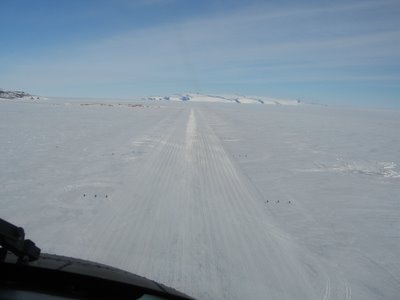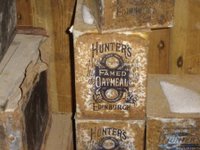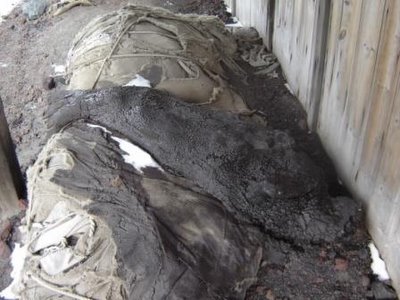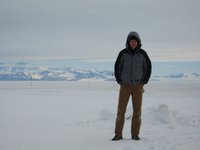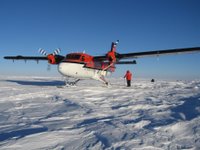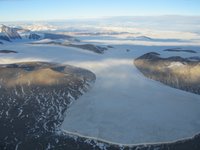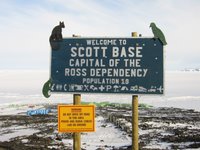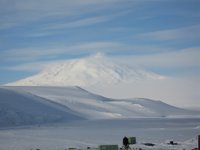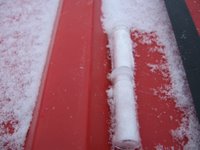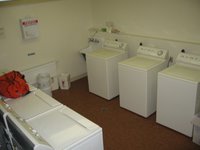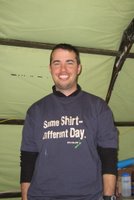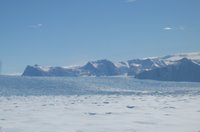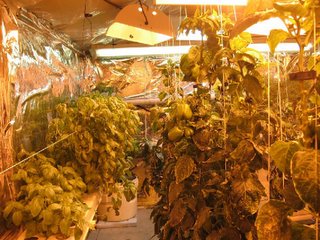Michael Pastirik, the High School teacher that is working with the ANTCI project, made some observations and took some photos today. Here is what he had to say:
McMurdo was gray and overcast last night. This morning the station was covered in a dusting of about three-quarters of an inch of powdery snow. It was beautiful.
There is a scheduled flight tonight at 2AM. Sounds late, but remember the sun doesnÂt set. All trips in the plane require that one takes their ECW and complete snow or happy camper school. Even though you didnÂt ask, there is no bathroom on the plane. The polite word for the device used is chamber pot, but everyone here says pee bottle. It is plastic and has a screw on top, so it will not get spilled during a bumpy flight. Enough said.
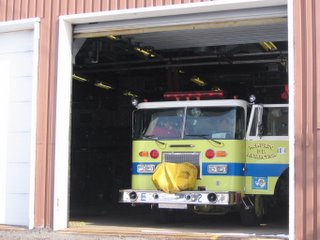 I strolled about town after working on the nitric oxide snow-sniffer (works fine!). The first stop was the firehouse. Firemen and Firewomen are responsible for a great number of things. At first, it might strike you as odd that there is a firehouse. However, remember that Antarctica is a desert, windy, and the station has all kinds of things to burn. If there is a fire, water has to be drawn from the total supply purified for the town, and if the power station burns, then the station or water plant needs to be evacuated in one or two days. There is little margin for error in Antarctica. In addition, to their fire fighting responsibilities, firemen let people into their rooms when they lose keys, clean oil and other spills, attend aircraft arrivals and departures in case of a disaster, and the list goes on.
I strolled about town after working on the nitric oxide snow-sniffer (works fine!). The first stop was the firehouse. Firemen and Firewomen are responsible for a great number of things. At first, it might strike you as odd that there is a firehouse. However, remember that Antarctica is a desert, windy, and the station has all kinds of things to burn. If there is a fire, water has to be drawn from the total supply purified for the town, and if the power station burns, then the station or water plant needs to be evacuated in one or two days. There is little margin for error in Antarctica. In addition, to their fire fighting responsibilities, firemen let people into their rooms when they lose keys, clean oil and other spills, attend aircraft arrivals and departures in case of a disaster, and the list goes on.
I continued my set of errands and went to the post office. It was there I met LaVonne H. Weber. I asked her about mail service in Antarctica. The shipping point in the States to and from Antarctica is San Francisco. Mail takes about three weeks to travel in either direction.. It costs the same to mail things here as it does back home. Mail arrives irregularly, with emergency transport and National Science Foundation (NSF) receiving priority. Four hundred pounds of mail arrived from the States last week.
Injuries happen, and people do get sick in Antarctica. If one needs medical care, there is the McMurdo Community Hospital. It is a small facility, but for more intense care, one is flown to New Zealand. Sometimes, it is not physical tending that people need, but spiritual time. The McMurdo Chapel is open to one and all. It overlooks McMurdo Sound. From it, over the transition (ice/ground area), one can see over the airport to the Transantarctic Mountains. The highest one tops 13,000 feet. It does make one contemplate the bigger picture.
Off to get a 12 foot bamboo pole with a red flag on it. Everything is flagged for safety. If there isnÂt a marked trail, or a flag trail (red or green), one should not go there. Casual walks in unmarked areas can be catastrophic. Search teams will look for you, but a foolish decision about not following rules and doing your own thing, can result in injury or death to you or rescuers. To say the least, this is frowned upon. By the way, two other flag colors are important to know. Black flags indicate danger, do not go there. An example of proper black flag use is to warn of crevasses. They are a constant source of danger. The other color flag is yellow. It is typically used as the indication for an outdoor field station pee site. There was someone on my happy camper school who seemed to be working on losing a popularity contest. He dug a trench for a shelter, and did a nice job at it. It took everything I knew to prevent myself (I wasnÂt alone in this.) from moving the pee flag to the edge of his trench once he fell asleep. For the record, I didnÂt do itÂ
 A minor thing struck me as I came back into the building today. All exterior building doors are very sturdy here. About half resemble industrial-size freezer door handles. In tropical and temperate climates, refrigerators are used to cool things, thick doors and sturdy handles prevent the inflow of heat. Here, in Antarctica, the cold surrounds us everywhere and the door keeps the heat in and the cold out!
A minor thing struck me as I came back into the building today. All exterior building doors are very sturdy here. About half resemble industrial-size freezer door handles. In tropical and temperate climates, refrigerators are used to cool things, thick doors and sturdy handles prevent the inflow of heat. Here, in Antarctica, the cold surrounds us everywhere and the door keeps the heat in and the cold out!
I talked with my wife (Barbara) and daughter (Carsen Lee) on the phone today. It is great to talk with them. It is hard to hang up. Tomorrow is Thanksgiving in the States. We will celebrate on Saturday night. Saturday morning I am going to participate in the Turkey Trot run/walk, eat, and I signed up to scrub pots and pans in the evening. I would like to think that a cafeteria worker could get the time off. Staff works hard here. Tonight, I plan to go over to the Kiwi Station (New Zealand) station named after Scott. I plan doing a bit of shopping, and having a bit of adult time.
Take care of one another! mp
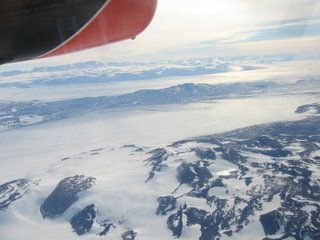 Yesterday, David returned from the Pole with the new nitric oxide instrument and installed it in the Twin Otter. And today was a busy day with a 2 hour Test Flight in the morning followed by a 5 hour Science Flight in the afternoon.
Here are some photos that Chuck (our pilot/co-pilot) took from the Twin Otter during the Test Flight. When the plane returned at 8:30 PM, I stayed around to download my data and then calibrated the zenith and nadir spectroradiometers. Normally, I can wait to do this tomorrow, but tomorrow morning (Thursday December 1st) the Twin Otter is heading for the South Pole.
Yesterday, David returned from the Pole with the new nitric oxide instrument and installed it in the Twin Otter. And today was a busy day with a 2 hour Test Flight in the morning followed by a 5 hour Science Flight in the afternoon.
Here are some photos that Chuck (our pilot/co-pilot) took from the Twin Otter during the Test Flight. When the plane returned at 8:30 PM, I stayed around to download my data and then calibrated the zenith and nadir spectroradiometers. Normally, I can wait to do this tomorrow, but tomorrow morning (Thursday December 1st) the Twin Otter is heading for the South Pole.
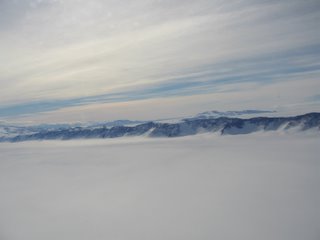 The trip to the South Pole will take about 10 hours of flying and the Twin Otter will have to refuel two times. As the crow flies, the distance between McMurdo and the South Pole is about 900 miles. Since the Twin Otter only flies at about 125 miles per hour. And has a range of about 500 miles, they will be stopping for fuel a couple of times on the way. One good reason to be at the Pole this weekend is that the Ice Runway is closing down. And the McMurdo airport is moving to Williams Field on the permanent ice shelf over by the New Zealand station (Scott Base). It is amazing that they can tow the Tower, the generator, the galley, the bathrooms, and all the other buildings to Willy Field in only 2 days.
The trip to the South Pole will take about 10 hours of flying and the Twin Otter will have to refuel two times. As the crow flies, the distance between McMurdo and the South Pole is about 900 miles. Since the Twin Otter only flies at about 125 miles per hour. And has a range of about 500 miles, they will be stopping for fuel a couple of times on the way. One good reason to be at the Pole this weekend is that the Ice Runway is closing down. And the McMurdo airport is moving to Williams Field on the permanent ice shelf over by the New Zealand station (Scott Base). It is amazing that they can tow the Tower, the generator, the galley, the bathrooms, and all the other buildings to Willy Field in only 2 days.

 While at the South Pole the crew will fly two local flights to survey the atmospheric chemistry on top of the plateau. And then on Monday they will fly back to McMurdo on the way they will stop a few times and also sample the nitric oxide in the snow and collect some shallow snow cores and surface snow samples that can be analyzed back at the labs at UNH (Jack Dibb) and UMaine (Karl Kruetz). While Fred, Dave, and Ed at the South Pole the rest of us will pack up all the equipment from our Jamesway at the Ice Runway and transport it back to the Crary Lab. Then on Friday a few of us (Jim, Will, and I) will take the Happy Camper School and learn how to survive by building a snow cave to sleep if we were to get stranded in the middle of nowhere.
While at the South Pole the crew will fly two local flights to survey the atmospheric chemistry on top of the plateau. And then on Monday they will fly back to McMurdo on the way they will stop a few times and also sample the nitric oxide in the snow and collect some shallow snow cores and surface snow samples that can be analyzed back at the labs at UNH (Jack Dibb) and UMaine (Karl Kruetz). While Fred, Dave, and Ed at the South Pole the rest of us will pack up all the equipment from our Jamesway at the Ice Runway and transport it back to the Crary Lab. Then on Friday a few of us (Jim, Will, and I) will take the Happy Camper School and learn how to survive by building a snow cave to sleep if we were to get stranded in the middle of nowhere.
